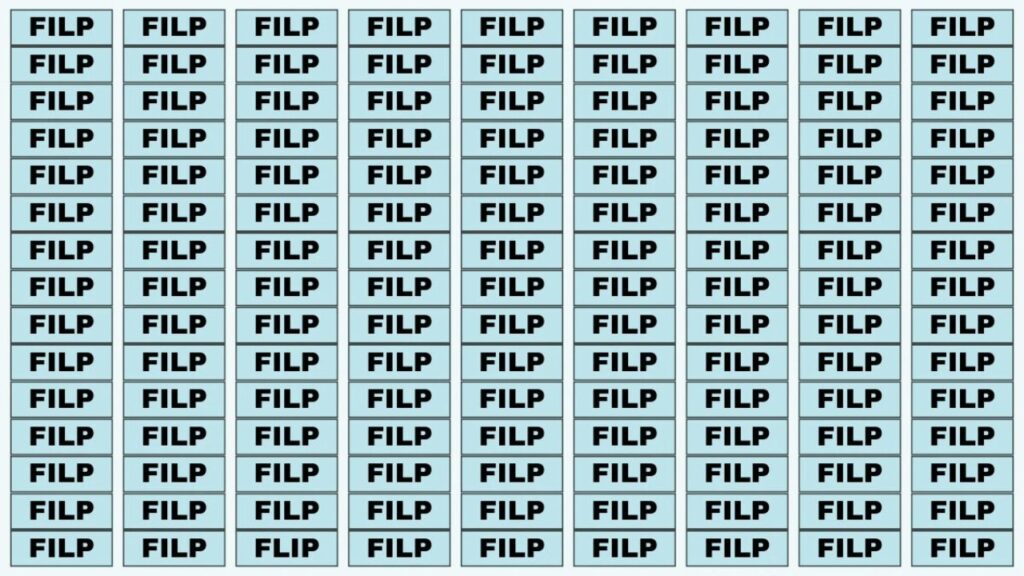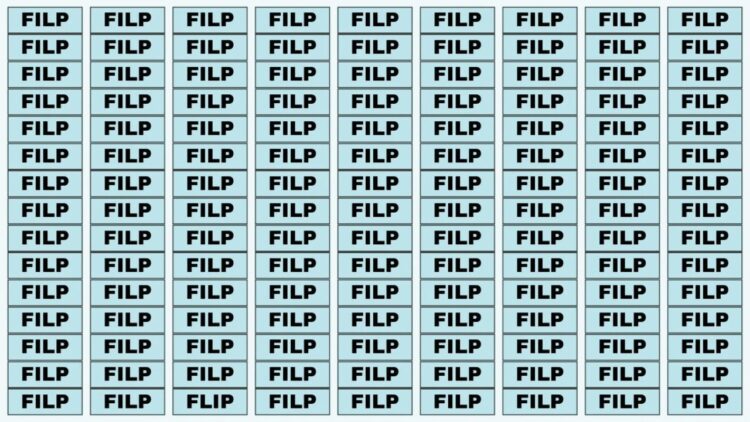If you think your eyesight and brain work perfectly together, think again. Optical illusions have a sneaky way of exposing the shortcuts our brains take when processing visual information. Today’s visual test is designed to challenge your perception, sharpen your focus, and even boost your cognitive abilities.
The challenge? Spot the word “FLIP” hidden among dozens of “FILP”s in under 6 seconds. Sounds simple, right? Don’t be so sure!
What Are Optical Illusions?
Optical illusions are images or visual puzzles that trick the brain into seeing something that isn’t there—or not seeing something that is.
These illusions exploit the way our brain processes patterns, contrasts, and shapes. Instead of examining every detail, the brain often fills in gaps based on assumptions, which can lead to errors in perception.
This natural shortcut works great for day-to-day efficiency but makes us vulnerable to illusion-based puzzles like the one you’re about to see.
Today’s Challenge: Can You Spot “FLIP” in 6 Seconds?
In this illusion puzzle, you’ll face a grid filled with the word “FILP”—yes, that’s an L and not the expected second letter I. Your task? Find the one occurrence of the word “FLIP” among them. The twist is that the two words look extremely similar, and your brain will naturally gloss over the difference.
You have only 6 seconds to find it. Set a timer, focus, and scroll down when you’re ready to start!

Why Is This Puzzle So Hard?
At a glance, “FILP” and “FLIP” look almost identical. But the difference between the two lies in the position of the letters “L” and “I”. When repeated across a grid, our brains tend to assume they are all the same. Here’s why it becomes tricky:
| Psychological Factor | Explanation |
|---|---|
| Pattern Recognition | The brain recognizes the pattern “FILP” and assumes all the others are the same. |
| Visual Fatigue | Staring at similar items causes the brain to ignore small inconsistencies. |
| Cognitive Shortcuts | Our brains are wired to skip redundant details to process faster. |
| Letter Similarity | “I” and “L” have similar vertical structures, making them easy to confuse. |
Tips to Spot “FLIP” Faster
If you didn’t find it in 6 seconds, don’t worry! Here are some smart strategies to train your brain for next time:
- Scan Left to Right: Our eyes naturally move this way, making it easier to catch differences in order.
- Focus on the Middle Letters: The difference between “FILP” and “FLIP” lies in the middle. Concentrate there.
- Avoid Reading the Whole Word: Just glance at letter positions rather than reading each word.
- Zoom Out: Sometimes, looking at the whole grid from a distance can reveal differences more easily.
The Reveal: Where Was “FLIP”?
If you’ve scrolled this far, you’re probably eager for the answer. In the original puzzle, “FLIP” was hidden in row 5, column 7—and yes, it really was that hard to spot!
Our brain automatically fills in familiar patterns, which makes the change almost invisible unless you’re hyper-focused. That’s what makes visual illusions not just fun, but useful cognitive training tools.

How Do These Puzzles Help the Brain?
Solving visual challenges like this one can improve cognitive functions, such as:
- Visual discrimination
- Attention span
- Memory recall
- Problem-solving speed
In fact, regularly participating in puzzles and illusions has been shown to help reduce cognitive decline with age and boost brain plasticity.
So, did you find “FLIP” in 6 seconds? If not, don’t worry—you’re in good company. These puzzles are designed to be tough. But with practice, your visual perception, attention to detail, and cognitive stamina will improve. Plus, they’re fun and addictive!
Feel free to share this challenge with friends and family to see who’s got the sharpest eyes in your circle. You might be surprised by who nails it!
FAQs
Are optical illusion puzzles suitable for all ages?
Yes, absolutely! They’re great for both kids and adults, enhancing focus, attention, and mental agility.
How often should I try these puzzles for brain health?
Even just one challenge a day can significantly improve your visual and cognitive performance over time.
Can solving optical illusions make me smarter?
While they won’t raise your IQ overnight, they train your brain to process visual data more effectively, which can boost problem-solving skills and alertness.

